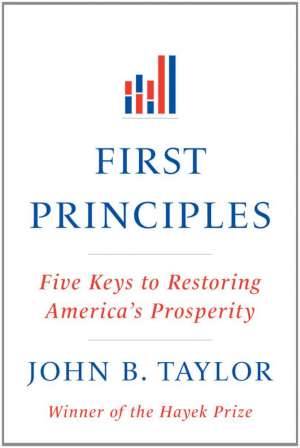01 May 2013
First Principles
Five Keys to Restoring America’s Prosperity
John B Taylor
2012, W W Norton & Company, 235 pages, £17.99
ISBN 0393345459
Reviewer: Stephen Hannah, Lecturer in Economics, NYU in London

This is a pre-election, pro-Republican polemic with a glowing recommendation from Congressman Ryan. So you should not be surprised by the content and its tone. However, you may well be disappointed, even saddened, by the argument.
John Taylor is undeniably a brilliant economist with an excellent research pedigree and plenty of hands-on policy experience. By all accounts he is a superb teacher and his textbooks are a triumph of clarity. His thoughts on sticky prices, contracts and the monetary ‘rule’ that bears his name are all part of our macro folklore. Regrettably, such skills are absent in what is a crude and embarrassing rant on US fiscal and monetary policy in the post-WW2 period.
Admittedly, the intention is to persuade the general reader of the benefits of free markets and limited government interference; it is not meant to be a tightly argued economic tome and is not designed for specialists. But the non sequiturs, the contradictions, the selective use of history, the ‘gee-whiz’ graphics and the US-is-the-centre-of-the-world insularity of the whole thing come across as intensely annoying and patronising.
The defining principles of economic freedom are set out early on:
- predictable policy framework
- rule of law
- strong incentives
- reliance on markets
- clearly limited role for government
We then get a grand, dare I say hackneyed, sweep of post-WW2 history about the bad Keynesian guys (Kennedy, Carter et al) followed by the good Market guys (he likes Reagan - yes the Reagan that brought us huge deficits and a grand US$ roller-coaster!). Then it all goes wrong again in the early noughties (when Keynesian activism “rose from the dead”) with the Fed keeping rates too low and disobeying the Taylor Rule. Bernanke is most definitely persona non grata and Summers’ “timely, targeted and temporary” policy dictum needs replacing, we are told, by “permanent, pervasive and predictable”.
More specifically, and this is just one of many examples, I imagine that an economics student reading this book would seriously wonder if Taylor actually understands his own Taylor Rule. The whole point is that the central bank has to make a judgment call about the Wicksellian rate. Over a decade ago, there was good reason for central banks thinking that the global real rate had fallen. They thought they were sticking to the Rule; it was only with the benefit of hindsight we know they were wrong. It was not indiscipline that was the problem; it was the inherent uncertainty about long-run parameters - uncertainty that makes rigid applications of rules so dangerous.
Similarly, the discussion on the debt/deficit drama that “portends America’s ending” descends into a risible discussion of crowding out that makes no allowances for liquidity constraints or the Fed’s pre-announcement of sustained near-zero rates.
The second chapter - the longest - focuses on naming and shaming. The initial section, covering Taylor’s early years in Washington, is entertaining and informative. But the commentary soon descends into a bland and unconvincing tirade about who is to blame for what. If only Nixon had “stayed the course” - a frequent Taylorism - then, apparently, the US would have been saved from its inflationary fate. Meaning that the US should have stuck with the gold link? In fact, Taylor does not even address that issue and, through the entire book, makes no significant reference to global forces (China, EMS, Russia, OPEC, etc) that were shaping the economic fortunes of the US for much of the period under discussion.
There are aspects of Taylor’s commentary that resonate - not least the discussion of crony capitalism and the costs of government intervention. But these nuggets are overwhelmed by the mediocrity of the general thrust.
Taylor finishes with a prediction that the book and its policy prescriptions are mainly “a story about what may be, not what will be.” Ah, the audacity of hope!
